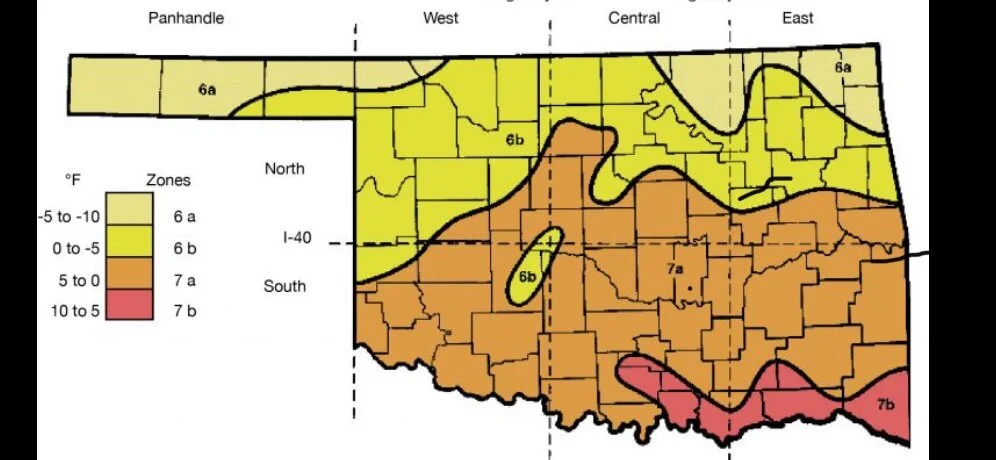What Your Landscape Wants You to Know About the Cold Weather Forecast
Overall, it has been a fairly mild winter. But, how it started and how it appears to be ending is hard on the landscape.
October’s three-day freezing rain came while leaves were still on trees resulting in damage to nearly every tree in the Oklahoma City area.
Now…we are faced with a forecast of extended freezing temperatures following several days of above-normal temperatures. Oh, and it has been nearly 2 weeks since most of the area benefited from a ¼” rainfall. And boy did the wind blow this week.
Why the weather review?
One of the most difficult situations for the landscape to overcome is spring-like days, when it is dry and windy, followed by an extended freeze. Plants gradually become acclimated to withstand low temperatures as we transition from fall to winter. Once they are fully acclimated, they can withstand cold spells. But, when they are exposed to warm days in late winter and early spring, their ability to withstand rapidly falling temperatures diminishes.
[Side note: Why is wind a problem? Evergreen shrubs store moisture in their leaves. During the winter, when temperatures are lower, transpiration (the release of water from plant leaves) is much lower. Well, except when the wind blows. Windy days zap the moisture stored in leaves making plants sensitive to winter injury during a harsh cold snap.]
So, what do you need to do today or tomorrow before the cold arrives?
1. Make sure your landscape is moist. Wet soil holds heat protecting root systems. Run your irrigation system through a cycle today or tomorrow. If your irrigation is winterized or you don’t have one, grab the water hose and water thoroughly around your shrubs, flowers, and trees.
Run your irrigation through a cycle before the cold arrives.
Mulch acts as a soil insulator keeping ground temperatures warmer in the winter and cooler in the summer.
2. Mulch around plants. A 2-3” layer of mulch will provide a layer of insulation for roots. Bare soil warms up too much on sunny winter days encouraging early root activity and in the extreme cold bare soil loses warmth quickly. A good layer of mulch will keep temperatures and moisture levels even.
3. Cover tender plants with sheets. The cover will act as insulation keeping the warm ground temperatures around the plants. Focus on plants with shallow root systems, new plantings, and ones that have started to bud. Remove covers as soon as temperatures rebound past freezing.
Covering tender plants with a sheet when temperatures are below freezing will trap the warmth of the ground around the plants.
The most common external symptoms caused by winter freezing are dieback, browning leaves, and bark splitting on the trunk. Dieback on the branches and brown foliage is common when freezing temperatures arrive suddenly after a few warm days.
You will find most plants to be resilient.
They will survive, bud, and produce new leaves as the weather warms in March.
Don’t overreact.
Wait until new buds and leaves form in the spring to make plant decisions.
Southwest injury is common in these conditions. It is an injury that develops on the south or southwest side of a tree trunk. On a warm, sunny February day it is common for bark temperatures to warm into the 60s on the sunny side. When temperatures suddenly drop below freezing, sap that has started to move up the tree, freezes cracking the bark. Young trees and ones with smooth bark, such as maples, are more susceptible. Protecting the trunk in the fall with a commercial wrap material helps prevent the problem.
The best preventive measure in avoiding winter damage is to select plants that are winter-hardy for our area. Cold hardiness is based on the USDA Plant Hardiness Zone Map. Central Oklahoma is in zones 6b and 7a. Plants rated 7a can withstand temperatures of 5 to 0 degrees while 6b goes as low as 0 to -5 degrees.
Southwest injury is caused when sap moving up the tree is frozen causing bark to crack and pop off the tree.
When selecting plants that are marginally hardy in our area, choosing the right site is critical. Keep in mind that south and west walls and concrete can create reflective heat resulting in damage from daily freezing and thawing. Also, avoid planting in locations where they will be exposed to drying winter winds. It is common to see plants better suited for zone 7b in the Oklahoma City metro when they are planted in the right location.
Keeping plants healthy during the growing season is an important step in surviving cold weather snaps. Plants in poor health are the first to suffer from weather stress. Rarely does a plant recommended for our area die from cold weather. Usually, many factors contribute to plants that die in the winter. Proper fertilizer applications, adequate moisture, and an integrated pest management program is critical to plant health.
Plants with shallow roots, such as Japanese Maple, are more susceptible to winter damage if their roots are dry during freezing temperatures.
Plants rarely die from winter kill. Typically they have been weakened by other factors such as bagworms.
Your landscape is a big investment. It is an investment that creates welcoming curb appeal and frequently results in higher home values.
If you have questions about the care of your landscape or if we can help you protect your landscape investment, give us a call.
Lorne Hall
Hall|Stewart Lawn + Landscape
(405)367-3873








